There are a few things to consider when buying your rabbit. Most of us will usually browse the look of, vibrating speeds, functions, length and battery life of our rabbit vibes. However, it is incredibly easy to overlook one of the most important features in our potential new best friends: the material they’re made out of.
Generally speaking, Rabbit vibes come in the following materials:
- Skin-safe rubber
- Silicone
- Jelly Rubber
- Plastic
Now, there are several things to take into account when considering the material your rabbit is made from. The first and most obvious would be allergies, particularly with those containing latex or any trace of phthalates. The second would be the look and feel of your vibrator – does it have a particular odour? Is it smooth or more coarse? Is it flexible? You might also consider the taste of your vibrator as well as another, often overlooked, factor which will impact upon the use of your favourite toy: which kind of lubrication it is compatible with?
Here’s a countdown to the potential pros and cons of your favourite rabbit vibrators and how the materials can impact upon your use of and compatibility with them:
The Silicone Vibrator
Pros
|
Cons
|
Silicone toys are often associated with luxury rabbits such as the Swan Range, the Picobong Kaya or the LELO range. These ‘designer’ brand names are typically more expensive. However, as Silicone-based toys have become more popular, more and more stockists are providing alternative, unbranded versions of these vibes.
Here is a video demonstration of how a silicone rabbit might look:
These toys are so popular because they are renowned for being hypoallergenic, non porous, easy to clean and for the malleability: they can be rigid, flexible or a mixture depending on the design. They are also incredibly long-lasting which means that, with proper care, they’ll rarely need to be replaced.
The taste and smell of these toys is practically non-existent and they generally contain no latex or phthalates. The texture is smooth and many manufacturers have used this quality to incorporate a seamless quality into their silicone rabbit toys.
LUBE
- Use water based lubricant.
Remember, when using a silicone toy, do not use a silicone lubricant: this can cause the toy to degrade. Instead, pair up with plenty of water-based lubrication.
Examples of Silicone Rabbit Vibrators
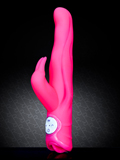
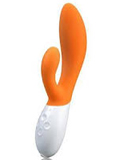

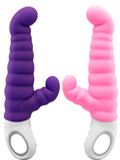
________________________________________________________________________________
The Skin Safe Rubber Vibrator
Pros
|
Cons
|
Skin safe rubber has a lot in common with silicone: it is latex free and doesn’t require the phthalates some other toys use in order to soften it. Like silicone, it is also non porous and incredibly easy to clean.
This type of vibrator will typically be firmer and, like the name implies, well, rubbery! It might emit a faint odour though many manufacturers aware of this do take measures to cancel this out. Skin safe rubber may also influence your decision when considering a rabbit made out of this material: it is firmer than most materials because of its lack of phthalates and therefore provides more pressure on the G-spot or clitoris.
A good visual demonstration of Skin safe rubber can be found here (the LoveHoney Jessica Rabbit Vibrator):
LUBE
- Water based
Water based lubricant is, again, a great option for this type of vibrator.
Examples of Skin Safe Rubber Vibrators
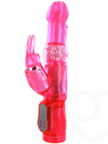
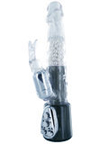
________________________________________________________________________________
Jelly Rubber Vibrators
Pros
|
Cons
|
Jelly rubber vibrators have the edge over skin safe or silicone vibrators in that they are compatible with silicone-based lubricants. This is particularly useful if you pick up a waterproof jelly rubber vibe, given that silicone-based lube performs particularly well in the shower or bath.
Jelly rubber is smooth, rubbery and flexible. It does however have a very chemical smell and taste to it so it’s not an ideal partner for oral play. Those with an allergy to latex might also want to give these vibes a miss since the product does contain latex and phthalates.
It is the cheaper alternative to the materials we’ve seen so far, and for this reason, does contain the softening properties of phthalates where skin-safe and silicone don’t. Jelly sex toys aren’t the most popular alternative around given that they’re less ‘skin-friendly’ than skin-safe rubber. In fact, both stockists LoveHoney and Bondara advise using a condom in order to safely enjoy your product.
Here is a good visual demonstration of a jelly rubber vibrator (Deluxe Pearl Rabbit Vibrator)
LUBE
- Can use silicone based lubrication.
Examples of Jelly Rubber Vibrators
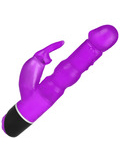
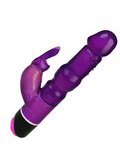
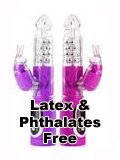
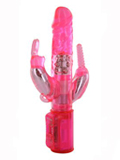
________________________________________________________________________________
Plastic Vibrators
Pros
|
Cons
|
These particular vibrators are often the cheapest of the bunch, along with the Jelly Rubber option. They, again, can be used with most types of water-based and silicone lubricant though are much firmer than most vibrators made of the other three materials mentioned here. You won’t often find a rabbit which utilises plastic as opposed to Jelly or Skin safe rubber. They are generally much tougher though more hygienic and easier to clean than most. They are also odourless, tasteless and, of course, contain no potentially harmful latex of phthalates for allergy sufferers.
In general, this material is used for finger or ‘classic’ style vibrators, though you will still find some plastic properties along the handles or shafts of the basic rabbit. The purpose of this is to usually add extra rigidity to the base of your rabbit and for easier access to any control panel it might have. The main rabbit itself will usually be made of a different, more flexible material.
A good visual demonstration can be found here:
Examples of Plastic Vibrators

________________________________________________________________________________
TPE/ TPR – Rubber/Plastics Combo
TPE/TPR is a combination of rubbers and plastics. This means you get the best of both types of materials. They can vary in how they feel and how firm they are depending on the combination used. You do find many toys that are strong/durable but soft too. They are easier to clean then jelly rubber toys as they are less porous. This is an advantage.
Other Combinations
There are many cross overs and mixtures when it comes to materials used to make rabbit vibrators. Some shafts can be a mixture of silicone and plastic, whereas others can be rubber and plastic. There are many different variations and you won’t always find a “pure” vibrator made from only one material. Most products will state this though and if not ask.
Latex & Phthalates
Latex and Phthalates are usually advertised as free from a majority of vibrators. It is a “feature” that is made to seem desirable. But are they ok or should we be diligent in avoiding them?
Latex
Latex is a naturally occurring plant based substance and for a lot of people does not cause any issue. Some people, however, have an allergy or are sensitive to it. If you have ever had a rash/irritation from wearing rubber gloves or even touching/using condoms then you may find you have a sensitivity or potential allergy to latex. You can easily get tested and find out for sure, but if you know you have some sort of reaction it is best to avoid a vibrator that contains it.
Fortunately most rabbit vibes do not have latex in, but if they do, it is only an issue if you are sensitive/have an allergy. Generally it is very clear whether a vibrator contains it or not as most will advertise it, however if not it can take just a simple email to the supplier to check.
Phthalates
Phthalates are chemicals used to soften plastic but at the same time make them harder to break. They can be found in toys, deodorant, tupperware and a number of household products as well as sex toys. It has been a hot topic for many years whether it is safe to be exposed to them. There have been concerns that it can lead to cancer/disrupt hormones and lead to infertility.
You may notice that it isn’t only sex toys that advertise their products as phthalates-free. This is because it is a major health concern and advertisers need to reassure customers that their product does not contain a potential health hazard.
As well as being linked to cancer and infertility, phthalates can also cause skin irritation and breathing difficulties.
It is very easy to avoid phthalates in vibrators. Generally most of them do not have these in them and will advertise as such. If not double check with the seller.
If you already have a vibrator that you think may have phthalates in – you can either recycle it or if you are unsure how you feel and want to continue using it – a condom can be a way to put a barrier up. Generally if it has quite a big chemical smell then it probably contains them.
Conclusion
Pretty much all major stockists and warehouses will provide information as to which material your rabbit is made from. As you can see, the material impacts a lot upon your intended use and desired response to your rabbit toy. A firmer material might enhance G-spot or clitoral stimulation for example, while a toy containing particular chemicals such as latex or phthalates might be better avoided for those with allergies or sensitive skin. The material your toy uses can also impact upon the types of lubrication you can use with your toy.
Arguably, one of the most misguided makes of a newer buyer is to ignore the material and come across a harmful reaction or simply be disappointed by the texture, feel or scent of their new rabbit. Avoid being one of them by being aware of what you’re buying, why you’re buying it. Ask yourself what your rabbit is really made of and what it could be worth to you.
